Analysis of Primary Health Care Strategies in Australia: Report
VerifiedAdded on 2022/09/28
|9
|2301
|78
Report
AI Summary
This report analyzes Australia's primary health care strategies, specifically focusing on the 'target known lifestyle-related health risk factors' strategy, with a focus on alcohol consumption and smoking. It explores the social determinants of health, including equity and social justice, highlighting how factors like education and socioeconomic status influence these behaviors and their consequences. The report examines epidemiological factors, such as age and gender, and their association with smoking and alcohol use rates in Australia, which are increasing. The report also delves into the five principles of the WHO for primary health care and their application to the chosen strategy. Finally, it discusses the significance of these strategies to nursing practice, considering the roles and responsibilities of nurses in addressing these public health issues. The report references government interventions, policies and research related to these issues.

Running head: PRIMARY HEALTH CARE 1
Public Health
Name:
Institution:
Date:
Public Health
Name:
Institution:
Date:
Paraphrase This Document
Need a fresh take? Get an instant paraphrase of this document with our AI Paraphraser
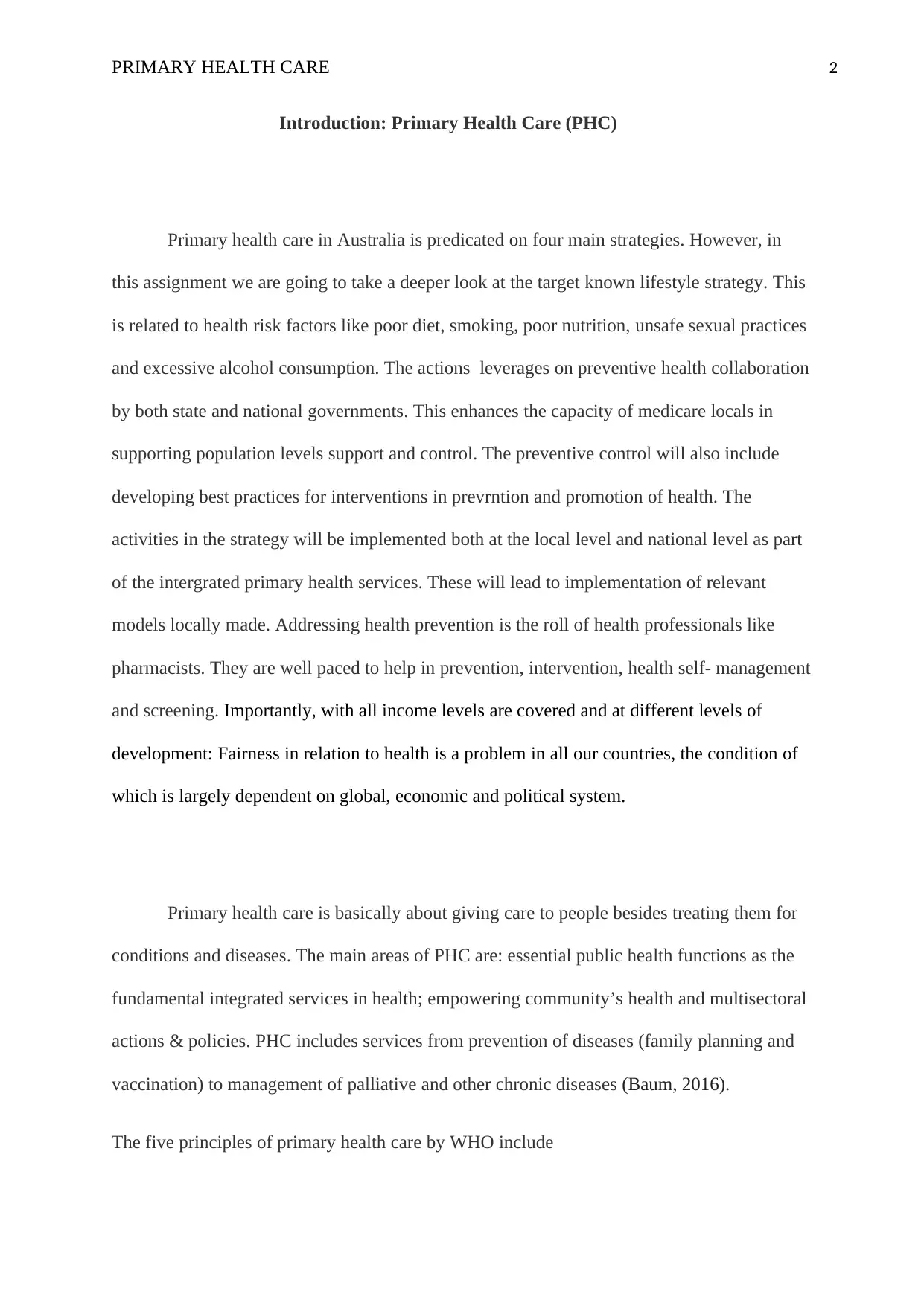
PRIMARY HEALTH CARE 2
Introduction: Primary Health Care (PHC)
Primary health care in Australia is predicated on four main strategies. However, in
this assignment we are going to take a deeper look at the target known lifestyle strategy. This
is related to health risk factors like poor diet, smoking, poor nutrition, unsafe sexual practices
and excessive alcohol consumption. The actions leverages on preventive health collaboration
by both state and national governments. This enhances the capacity of medicare locals in
supporting population levels support and control. The preventive control will also include
developing best practices for interventions in prevrntion and promotion of health. The
activities in the strategy will be implemented both at the local level and national level as part
of the intergrated primary health services. These will lead to implementation of relevant
models locally made. Addressing health prevention is the roll of health professionals like
pharmacists. They are well paced to help in prevention, intervention, health self- management
and screening. Importantly, with all income levels are covered and at different levels of
development: Fairness in relation to health is a problem in all our countries, the condition of
which is largely dependent on global, economic and political system.
Primary health care is basically about giving care to people besides treating them for
conditions and diseases. The main areas of PHC are: essential public health functions as the
fundamental integrated services in health; empowering community’s health and multisectoral
actions & policies. PHC includes services from prevention of diseases (family planning and
vaccination) to management of palliative and other chronic diseases (Baum, 2016).
The five principles of primary health care by WHO include
Introduction: Primary Health Care (PHC)
Primary health care in Australia is predicated on four main strategies. However, in
this assignment we are going to take a deeper look at the target known lifestyle strategy. This
is related to health risk factors like poor diet, smoking, poor nutrition, unsafe sexual practices
and excessive alcohol consumption. The actions leverages on preventive health collaboration
by both state and national governments. This enhances the capacity of medicare locals in
supporting population levels support and control. The preventive control will also include
developing best practices for interventions in prevrntion and promotion of health. The
activities in the strategy will be implemented both at the local level and national level as part
of the intergrated primary health services. These will lead to implementation of relevant
models locally made. Addressing health prevention is the roll of health professionals like
pharmacists. They are well paced to help in prevention, intervention, health self- management
and screening. Importantly, with all income levels are covered and at different levels of
development: Fairness in relation to health is a problem in all our countries, the condition of
which is largely dependent on global, economic and political system.
Primary health care is basically about giving care to people besides treating them for
conditions and diseases. The main areas of PHC are: essential public health functions as the
fundamental integrated services in health; empowering community’s health and multisectoral
actions & policies. PHC includes services from prevention of diseases (family planning and
vaccination) to management of palliative and other chronic diseases (Baum, 2016).
The five principles of primary health care by WHO include

PRIMARY HEALTH CARE 3
1. Organizing peoples needs and expectations and organizing them around health
services.
2. Reducing social disparities and exclusion of people in health facilities.
3. Increasing participation by stakeholders
4. Public policy reforms and intergrating health into different sectors
5. Pursuing leadership reforms through cloaborative dialogues policy models.
For the Australian government, the primary health principle are centred around:
organizing the peoples needs and expectations around health services. It is important that the
government organizes and plans for peoples health depending on their needs. It is also
important that the government reduce social disparities and exclusion of people from health
services. The government should exercise equity in sitribution and planning of health
strategies. It should also ensure that there is maximum input from industry stakeholders such
as doctors, sataes and the national government. Public policy and reforms should also
intergrate health into different sectors while Pursuing leadership reforms through cloaborative
dialogues policy models.
Social determinates are the conditions that an individual grows in, are born in, work ,
live and age that can lead to him or her being an alcoholic or a smoker. In Australia, many
people either use alcohol or smoke tobacco or both. Little has been done to examine alcohol
use and alcohol related challengesd that arise from social determinants and inequeties
perspective. Studies conducted in Australia reviewed the evidence based on inequeties of
alcoholism and cigarette smoking(Gage, et al ,2018). Research has aslo been done on
alcoholism in Australia and appropriate actions that would promote health equity. The
governments aspirations for equity in health, must take their place in the search of a balanced
approach to addressing the needs of social and economic development of the entire
population, equity in health and relevance.
1. Organizing peoples needs and expectations and organizing them around health
services.
2. Reducing social disparities and exclusion of people in health facilities.
3. Increasing participation by stakeholders
4. Public policy reforms and intergrating health into different sectors
5. Pursuing leadership reforms through cloaborative dialogues policy models.
For the Australian government, the primary health principle are centred around:
organizing the peoples needs and expectations around health services. It is important that the
government organizes and plans for peoples health depending on their needs. It is also
important that the government reduce social disparities and exclusion of people from health
services. The government should exercise equity in sitribution and planning of health
strategies. It should also ensure that there is maximum input from industry stakeholders such
as doctors, sataes and the national government. Public policy and reforms should also
intergrate health into different sectors while Pursuing leadership reforms through cloaborative
dialogues policy models.
Social determinates are the conditions that an individual grows in, are born in, work ,
live and age that can lead to him or her being an alcoholic or a smoker. In Australia, many
people either use alcohol or smoke tobacco or both. Little has been done to examine alcohol
use and alcohol related challengesd that arise from social determinants and inequeties
perspective. Studies conducted in Australia reviewed the evidence based on inequeties of
alcoholism and cigarette smoking(Gage, et al ,2018). Research has aslo been done on
alcoholism in Australia and appropriate actions that would promote health equity. The
governments aspirations for equity in health, must take their place in the search of a balanced
approach to addressing the needs of social and economic development of the entire
population, equity in health and relevance.
⊘ This is a preview!⊘
Do you want full access?
Subscribe today to unlock all pages.

Trusted by 1+ million students worldwide
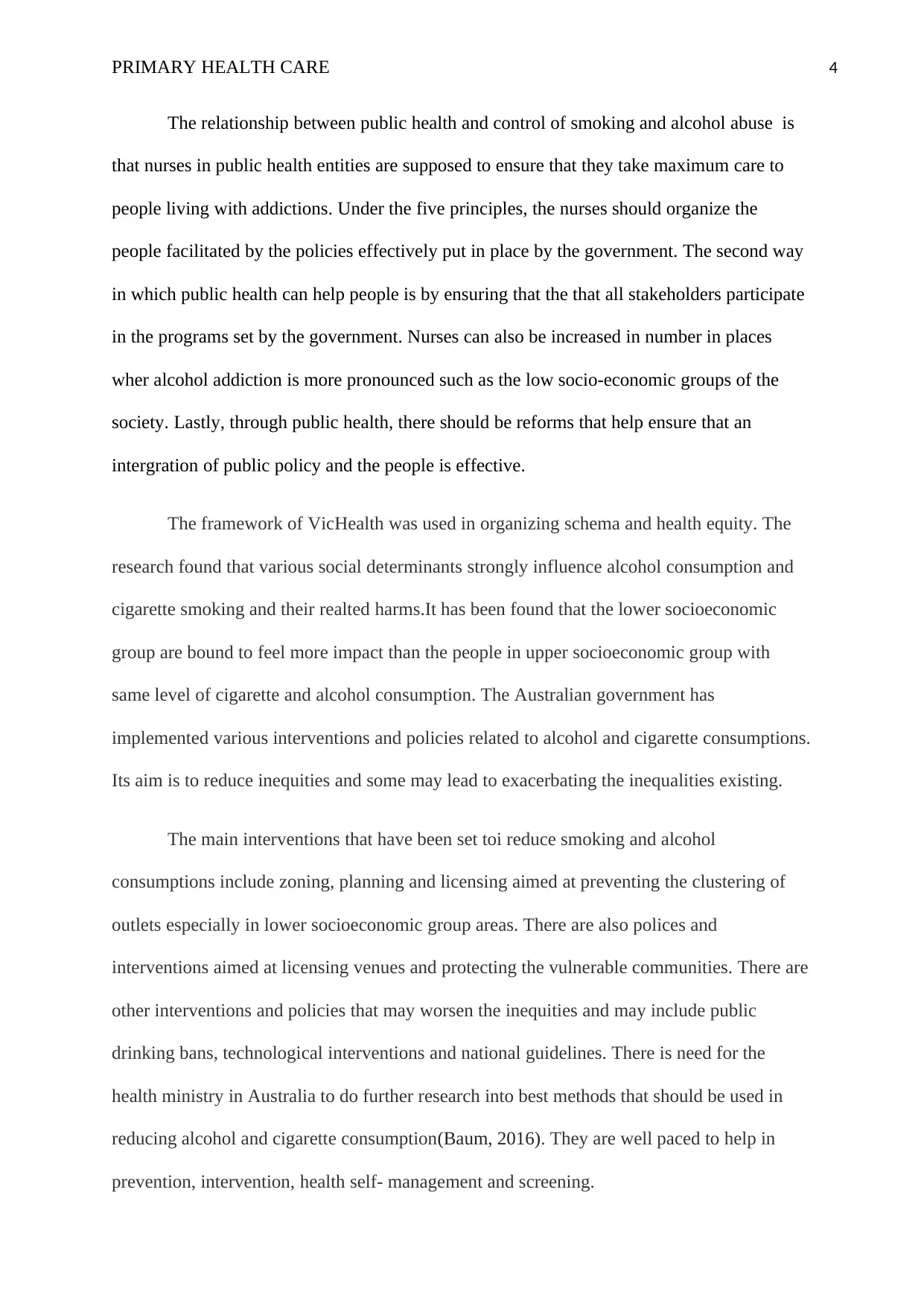
PRIMARY HEALTH CARE 4
The relationship between public health and control of smoking and alcohol abuse is
that nurses in public health entities are supposed to ensure that they take maximum care to
people living with addictions. Under the five principles, the nurses should organize the
people facilitated by the policies effectively put in place by the government. The second way
in which public health can help people is by ensuring that the that all stakeholders participate
in the programs set by the government. Nurses can also be increased in number in places
wher alcohol addiction is more pronounced such as the low socio-economic groups of the
society. Lastly, through public health, there should be reforms that help ensure that an
intergration of public policy and the people is effective.
The framework of VicHealth was used in organizing schema and health equity. The
research found that various social determinants strongly influence alcohol consumption and
cigarette smoking and their realted harms.It has been found that the lower socioeconomic
group are bound to feel more impact than the people in upper socioeconomic group with
same level of cigarette and alcohol consumption. The Australian government has
implemented various interventions and policies related to alcohol and cigarette consumptions.
Its aim is to reduce inequities and some may lead to exacerbating the inequalities existing.
The main interventions that have been set toi reduce smoking and alcohol
consumptions include zoning, planning and licensing aimed at preventing the clustering of
outlets especially in lower socioeconomic group areas. There are also polices and
interventions aimed at licensing venues and protecting the vulnerable communities. There are
other interventions and policies that may worsen the inequities and may include public
drinking bans, technological interventions and national guidelines. There is need for the
health ministry in Australia to do further research into best methods that should be used in
reducing alcohol and cigarette consumption(Baum, 2016). They are well paced to help in
prevention, intervention, health self- management and screening.
The relationship between public health and control of smoking and alcohol abuse is
that nurses in public health entities are supposed to ensure that they take maximum care to
people living with addictions. Under the five principles, the nurses should organize the
people facilitated by the policies effectively put in place by the government. The second way
in which public health can help people is by ensuring that the that all stakeholders participate
in the programs set by the government. Nurses can also be increased in number in places
wher alcohol addiction is more pronounced such as the low socio-economic groups of the
society. Lastly, through public health, there should be reforms that help ensure that an
intergration of public policy and the people is effective.
The framework of VicHealth was used in organizing schema and health equity. The
research found that various social determinants strongly influence alcohol consumption and
cigarette smoking and their realted harms.It has been found that the lower socioeconomic
group are bound to feel more impact than the people in upper socioeconomic group with
same level of cigarette and alcohol consumption. The Australian government has
implemented various interventions and policies related to alcohol and cigarette consumptions.
Its aim is to reduce inequities and some may lead to exacerbating the inequalities existing.
The main interventions that have been set toi reduce smoking and alcohol
consumptions include zoning, planning and licensing aimed at preventing the clustering of
outlets especially in lower socioeconomic group areas. There are also polices and
interventions aimed at licensing venues and protecting the vulnerable communities. There are
other interventions and policies that may worsen the inequities and may include public
drinking bans, technological interventions and national guidelines. There is need for the
health ministry in Australia to do further research into best methods that should be used in
reducing alcohol and cigarette consumption(Baum, 2016). They are well paced to help in
prevention, intervention, health self- management and screening.
Paraphrase This Document
Need a fresh take? Get an instant paraphrase of this document with our AI Paraphraser

PRIMARY HEALTH CARE 5
The well being and health of a person are influenced by peoples material and social
environments. There are differences in capacity and opportunities among people of the two
socioeconomic status. Health inequities affect poor people the most. Although health polcies
by the government should aim to help the two groups, more emphasies should be put on
lower socioeconomic zones as they are the one highly susceptible to alcoholism and cigarette
smoking.
Social Determinates of Primary Health Care
The principles in the 1978 WHO primary health care policy include;
Accessibility- Making sure that the health systems and care is accessible and cover on
the basis of need
Affordability- commitment to affordable service in health irrespective of gender,
ethnicity, location or age.
Commitment to equity and better health distribution as a core function of
development of health systems through social justice
Intersectoral health approach
Australia’s current key strategies in Primary Health Care policies
The vision for the Australian government for National Health and Hospitals Network
to meet health requirements needs for Australians in the 21st century is a strong PHC sector
that provides efficient and effective health care services to individuals and local communities.
(Gage, et al ,2018). It will be responsible for 60% of training, funding, research and capital
needed in the health systems.
The well being and health of a person are influenced by peoples material and social
environments. There are differences in capacity and opportunities among people of the two
socioeconomic status. Health inequities affect poor people the most. Although health polcies
by the government should aim to help the two groups, more emphasies should be put on
lower socioeconomic zones as they are the one highly susceptible to alcoholism and cigarette
smoking.
Social Determinates of Primary Health Care
The principles in the 1978 WHO primary health care policy include;
Accessibility- Making sure that the health systems and care is accessible and cover on
the basis of need
Affordability- commitment to affordable service in health irrespective of gender,
ethnicity, location or age.
Commitment to equity and better health distribution as a core function of
development of health systems through social justice
Intersectoral health approach
Australia’s current key strategies in Primary Health Care policies
The vision for the Australian government for National Health and Hospitals Network
to meet health requirements needs for Australians in the 21st century is a strong PHC sector
that provides efficient and effective health care services to individuals and local communities.
(Gage, et al ,2018). It will be responsible for 60% of training, funding, research and capital
needed in the health systems.
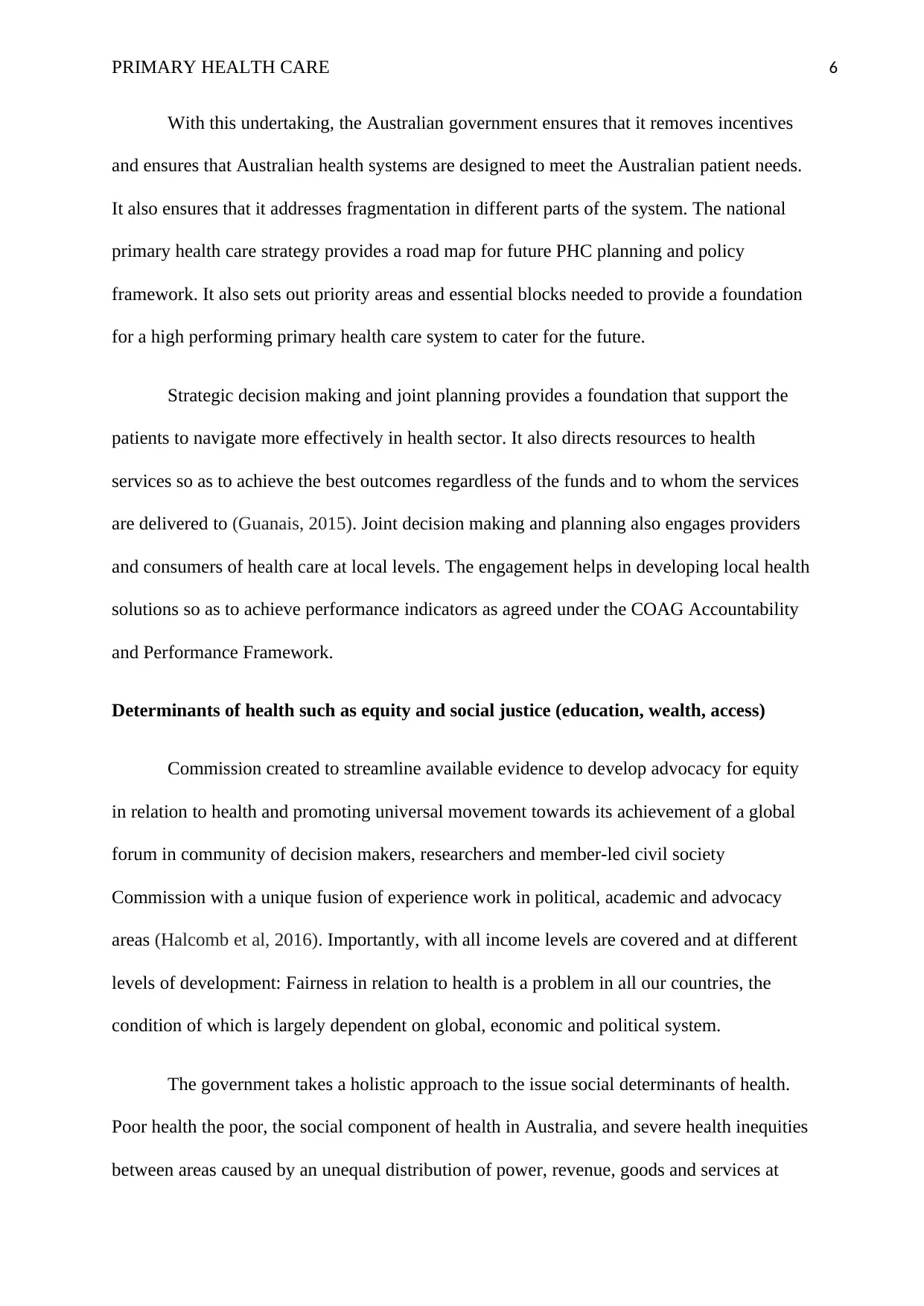
PRIMARY HEALTH CARE 6
With this undertaking, the Australian government ensures that it removes incentives
and ensures that Australian health systems are designed to meet the Australian patient needs.
It also ensures that it addresses fragmentation in different parts of the system. The national
primary health care strategy provides a road map for future PHC planning and policy
framework. It also sets out priority areas and essential blocks needed to provide a foundation
for a high performing primary health care system to cater for the future.
Strategic decision making and joint planning provides a foundation that support the
patients to navigate more effectively in health sector. It also directs resources to health
services so as to achieve the best outcomes regardless of the funds and to whom the services
are delivered to (Guanais, 2015). Joint decision making and planning also engages providers
and consumers of health care at local levels. The engagement helps in developing local health
solutions so as to achieve performance indicators as agreed under the COAG Accountability
and Performance Framework.
Determinants of health such as equity and social justice (education, wealth, access)
Commission created to streamline available evidence to develop advocacy for equity
in relation to health and promoting universal movement towards its achievement of a global
forum in community of decision makers, researchers and member-led civil society
Commission with a unique fusion of experience work in political, academic and advocacy
areas (Halcomb et al, 2016). Importantly, with all income levels are covered and at different
levels of development: Fairness in relation to health is a problem in all our countries, the
condition of which is largely dependent on global, economic and political system.
The government takes a holistic approach to the issue social determinants of health.
Poor health the poor, the social component of health in Australia, and severe health inequities
between areas caused by an unequal distribution of power, revenue, goods and services at
With this undertaking, the Australian government ensures that it removes incentives
and ensures that Australian health systems are designed to meet the Australian patient needs.
It also ensures that it addresses fragmentation in different parts of the system. The national
primary health care strategy provides a road map for future PHC planning and policy
framework. It also sets out priority areas and essential blocks needed to provide a foundation
for a high performing primary health care system to cater for the future.
Strategic decision making and joint planning provides a foundation that support the
patients to navigate more effectively in health sector. It also directs resources to health
services so as to achieve the best outcomes regardless of the funds and to whom the services
are delivered to (Guanais, 2015). Joint decision making and planning also engages providers
and consumers of health care at local levels. The engagement helps in developing local health
solutions so as to achieve performance indicators as agreed under the COAG Accountability
and Performance Framework.
Determinants of health such as equity and social justice (education, wealth, access)
Commission created to streamline available evidence to develop advocacy for equity
in relation to health and promoting universal movement towards its achievement of a global
forum in community of decision makers, researchers and member-led civil society
Commission with a unique fusion of experience work in political, academic and advocacy
areas (Halcomb et al, 2016). Importantly, with all income levels are covered and at different
levels of development: Fairness in relation to health is a problem in all our countries, the
condition of which is largely dependent on global, economic and political system.
The government takes a holistic approach to the issue social determinants of health.
Poor health the poor, the social component of health in Australia, and severe health inequities
between areas caused by an unequal distribution of power, revenue, goods and services at
⊘ This is a preview!⊘
Do you want full access?
Subscribe today to unlock all pages.

Trusted by 1+ million students worldwide
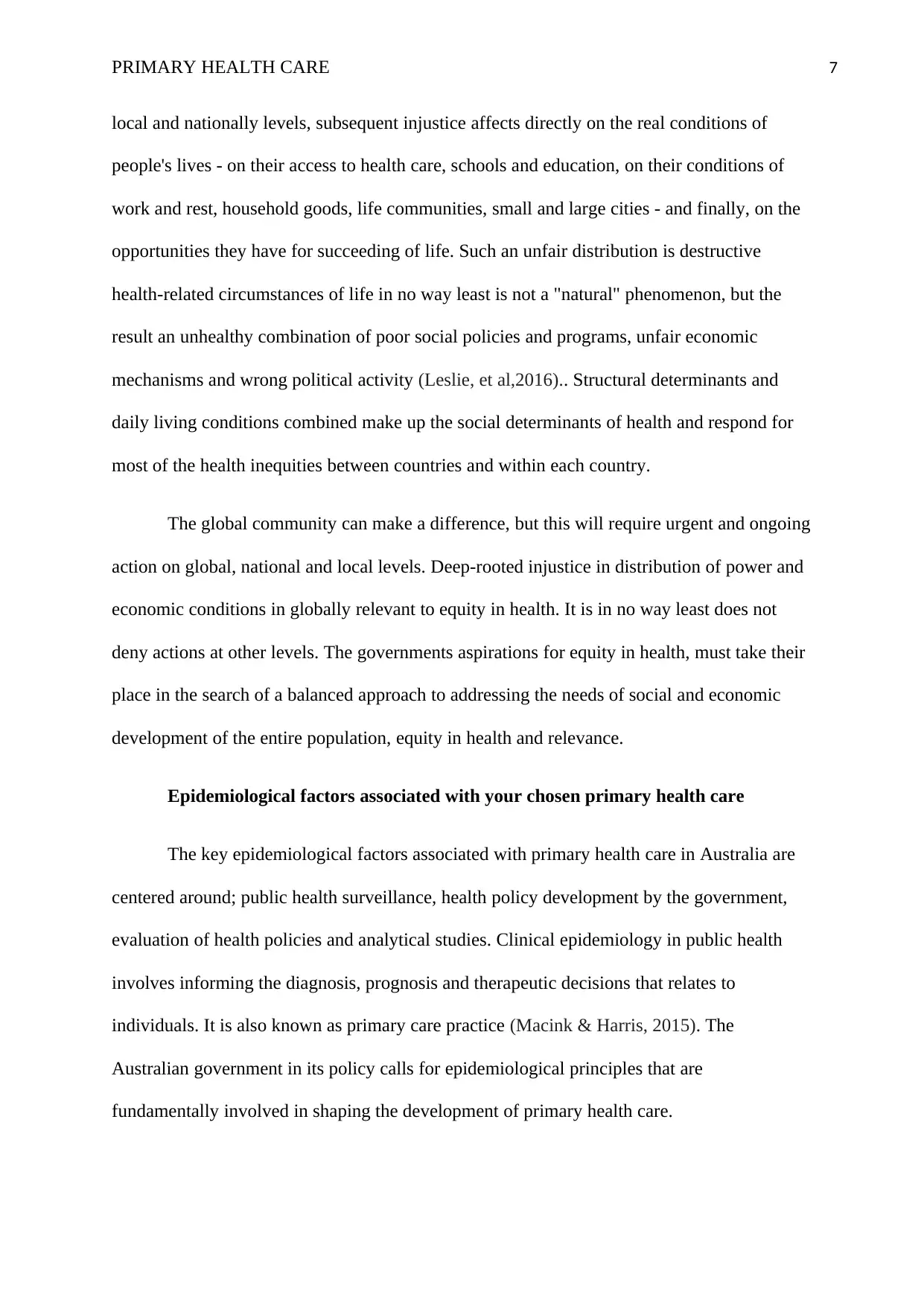
PRIMARY HEALTH CARE 7
local and nationally levels, subsequent injustice affects directly on the real conditions of
people's lives - on their access to health care, schools and education, on their conditions of
work and rest, household goods, life communities, small and large cities - and finally, on the
opportunities they have for succeeding of life. Such an unfair distribution is destructive
health-related circumstances of life in no way least is not a "natural" phenomenon, but the
result an unhealthy combination of poor social policies and programs, unfair economic
mechanisms and wrong political activity (Leslie, et al,2016).. Structural determinants and
daily living conditions combined make up the social determinants of health and respond for
most of the health inequities between countries and within each country.
The global community can make a difference, but this will require urgent and ongoing
action on global, national and local levels. Deep-rooted injustice in distribution of power and
economic conditions in globally relevant to equity in health. It is in no way least does not
deny actions at other levels. The governments aspirations for equity in health, must take their
place in the search of a balanced approach to addressing the needs of social and economic
development of the entire population, equity in health and relevance.
Epidemiological factors associated with your chosen primary health care
The key epidemiological factors associated with primary health care in Australia are
centered around; public health surveillance, health policy development by the government,
evaluation of health policies and analytical studies. Clinical epidemiology in public health
involves informing the diagnosis, prognosis and therapeutic decisions that relates to
individuals. It is also known as primary care practice (Macink & Harris, 2015). The
Australian government in its policy calls for epidemiological principles that are
fundamentally involved in shaping the development of primary health care.
local and nationally levels, subsequent injustice affects directly on the real conditions of
people's lives - on their access to health care, schools and education, on their conditions of
work and rest, household goods, life communities, small and large cities - and finally, on the
opportunities they have for succeeding of life. Such an unfair distribution is destructive
health-related circumstances of life in no way least is not a "natural" phenomenon, but the
result an unhealthy combination of poor social policies and programs, unfair economic
mechanisms and wrong political activity (Leslie, et al,2016).. Structural determinants and
daily living conditions combined make up the social determinants of health and respond for
most of the health inequities between countries and within each country.
The global community can make a difference, but this will require urgent and ongoing
action on global, national and local levels. Deep-rooted injustice in distribution of power and
economic conditions in globally relevant to equity in health. It is in no way least does not
deny actions at other levels. The governments aspirations for equity in health, must take their
place in the search of a balanced approach to addressing the needs of social and economic
development of the entire population, equity in health and relevance.
Epidemiological factors associated with your chosen primary health care
The key epidemiological factors associated with primary health care in Australia are
centered around; public health surveillance, health policy development by the government,
evaluation of health policies and analytical studies. Clinical epidemiology in public health
involves informing the diagnosis, prognosis and therapeutic decisions that relates to
individuals. It is also known as primary care practice (Macink & Harris, 2015). The
Australian government in its policy calls for epidemiological principles that are
fundamentally involved in shaping the development of primary health care.
Paraphrase This Document
Need a fresh take? Get an instant paraphrase of this document with our AI Paraphraser
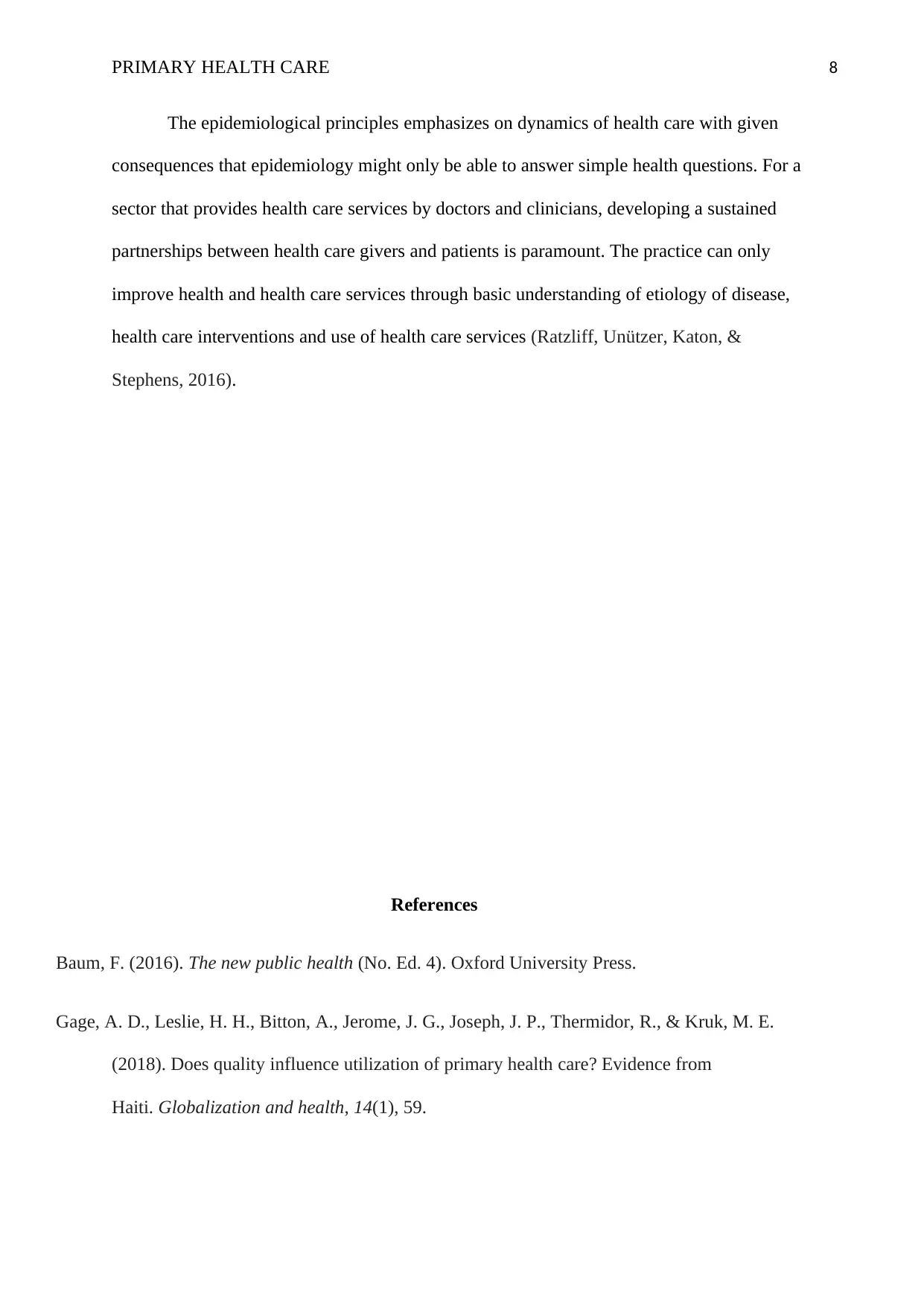
PRIMARY HEALTH CARE 8
The epidemiological principles emphasizes on dynamics of health care with given
consequences that epidemiology might only be able to answer simple health questions. For a
sector that provides health care services by doctors and clinicians, developing a sustained
partnerships between health care givers and patients is paramount. The practice can only
improve health and health care services through basic understanding of etiology of disease,
health care interventions and use of health care services (Ratzliff, Unützer, Katon, &
Stephens, 2016).
References
Baum, F. (2016). The new public health (No. Ed. 4). Oxford University Press.
Gage, A. D., Leslie, H. H., Bitton, A., Jerome, J. G., Joseph, J. P., Thermidor, R., & Kruk, M. E.
(2018). Does quality influence utilization of primary health care? Evidence from
Haiti. Globalization and health, 14(1), 59.
The epidemiological principles emphasizes on dynamics of health care with given
consequences that epidemiology might only be able to answer simple health questions. For a
sector that provides health care services by doctors and clinicians, developing a sustained
partnerships between health care givers and patients is paramount. The practice can only
improve health and health care services through basic understanding of etiology of disease,
health care interventions and use of health care services (Ratzliff, Unützer, Katon, &
Stephens, 2016).
References
Baum, F. (2016). The new public health (No. Ed. 4). Oxford University Press.
Gage, A. D., Leslie, H. H., Bitton, A., Jerome, J. G., Joseph, J. P., Thermidor, R., & Kruk, M. E.
(2018). Does quality influence utilization of primary health care? Evidence from
Haiti. Globalization and health, 14(1), 59.
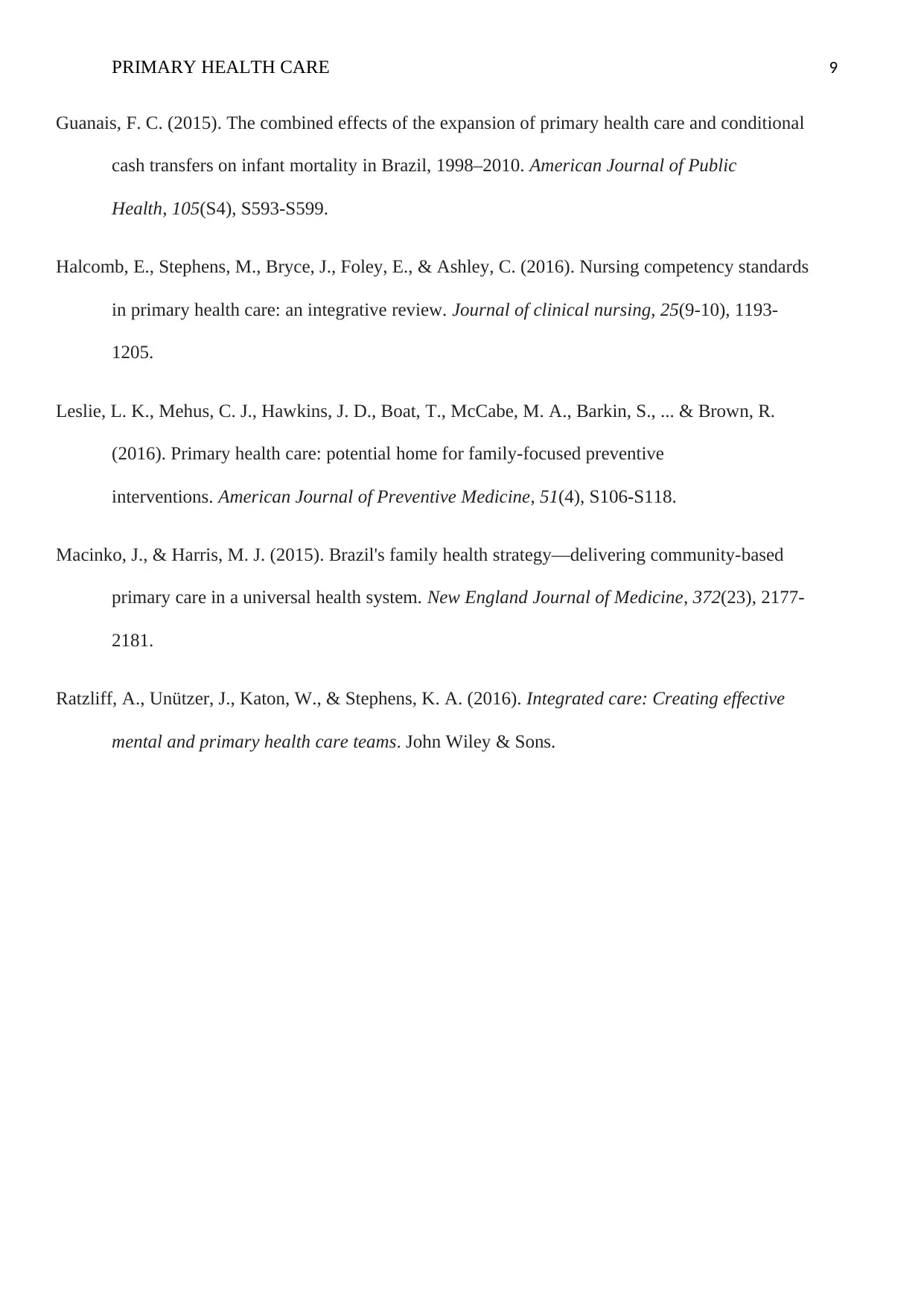
PRIMARY HEALTH CARE 9
Guanais, F. C. (2015). The combined effects of the expansion of primary health care and conditional
cash transfers on infant mortality in Brazil, 1998–2010. American Journal of Public
Health, 105(S4), S593-S599.
Halcomb, E., Stephens, M., Bryce, J., Foley, E., & Ashley, C. (2016). Nursing competency standards
in primary health care: an integrative review. Journal of clinical nursing, 25(9-10), 1193-
1205.
Leslie, L. K., Mehus, C. J., Hawkins, J. D., Boat, T., McCabe, M. A., Barkin, S., ... & Brown, R.
(2016). Primary health care: potential home for family-focused preventive
interventions. American Journal of Preventive Medicine, 51(4), S106-S118.
Macinko, J., & Harris, M. J. (2015). Brazil's family health strategy—delivering community-based
primary care in a universal health system. New England Journal of Medicine, 372(23), 2177-
2181.
Ratzliff, A., Unützer, J., Katon, W., & Stephens, K. A. (2016). Integrated care: Creating effective
mental and primary health care teams. John Wiley & Sons.
Guanais, F. C. (2015). The combined effects of the expansion of primary health care and conditional
cash transfers on infant mortality in Brazil, 1998–2010. American Journal of Public
Health, 105(S4), S593-S599.
Halcomb, E., Stephens, M., Bryce, J., Foley, E., & Ashley, C. (2016). Nursing competency standards
in primary health care: an integrative review. Journal of clinical nursing, 25(9-10), 1193-
1205.
Leslie, L. K., Mehus, C. J., Hawkins, J. D., Boat, T., McCabe, M. A., Barkin, S., ... & Brown, R.
(2016). Primary health care: potential home for family-focused preventive
interventions. American Journal of Preventive Medicine, 51(4), S106-S118.
Macinko, J., & Harris, M. J. (2015). Brazil's family health strategy—delivering community-based
primary care in a universal health system. New England Journal of Medicine, 372(23), 2177-
2181.
Ratzliff, A., Unützer, J., Katon, W., & Stephens, K. A. (2016). Integrated care: Creating effective
mental and primary health care teams. John Wiley & Sons.
⊘ This is a preview!⊘
Do you want full access?
Subscribe today to unlock all pages.

Trusted by 1+ million students worldwide
1 out of 9
Related Documents
Your All-in-One AI-Powered Toolkit for Academic Success.
+13062052269
info@desklib.com
Available 24*7 on WhatsApp / Email
![[object Object]](/_next/static/media/star-bottom.7253800d.svg)
Unlock your academic potential
Copyright © 2020–2025 A2Z Services. All Rights Reserved. Developed and managed by ZUCOL.





